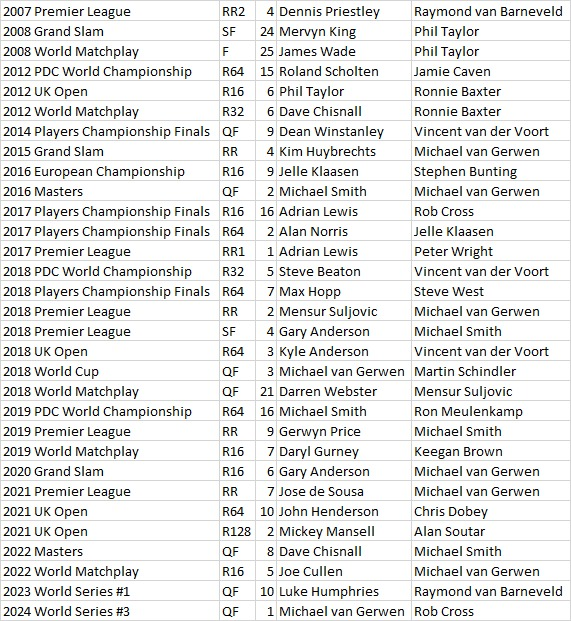
In his latest column, PDC Stats Analyst Christopher Kempf analyses the rare phenomenon of four 180s being hit in the same leg...

The moment is captured in a grainy video from 17 years ago, recorded in Blackburn in a Premier League match between Raymond van Barneveld and Dennis Priestley.
A fan, having witnessed a truly rare and remarkable occurrence - two players attempting a nine-dart finish in the same leg - pulls out a camera and starts filming just as Van Barneveld is about to attempt his 141 checkout.
No details of the dartboard or of the darts can be made out on the footage - the only information we can gather about the success of the player's throws comes from the crowd's reactions.
But the fan has begun recording too late - the conclusion to the leg is anti-climactic.
Van Barneveld goes seven darts into his nine-dart finish before missing the treble 19; Priestley, whom the crowd encourages to no end as he attempts his own 141 finish, misses his first target.
The match was televised on Sky Sports in the UK and represented a first in PDC darts - a leg containing four 180s.
Give a professional darts player three darts to throw at treble 20 and for every 15 attempts, he will score 180 about once.
In the 2024 Premier League 660 180s were thrown across 1,106 legs, for a rate of about 0.597 180s per leg played.
Unsurprisingly, legs with multiple 180s are uncommon. Only one leg out of every 11 in this year's Premier League contained two 180s, and most Premier League nights did not contain a leg with three 180s - there were only 12 overall.
It was not until the US Darts Masters that a year-long drought of televised four-180 legs was ended, courtesy of Rob Cross and Michael van Gerwen.
Given a 1/15 probability per visit that a player will throw a 180, we would expect two players to combine for 180s in four consecutive visits once in every 50,000 attempts.
There are a total of 31 known four-180 legs in televised PDC matches. Only a handful take the form of that pioneering Priestley-van Barneveld leg, in which the four maxima set up dueling nine-darter attempts (none have, to date, resulted in a successful nine-darter).
Far more common are legs in which a player has a poor starting visit, then recovers with 360 points in 6 darts.
No player has been a participant in more of these legs than van Gerwen (7), but after a 16-year drought, his countryman Van Barneveld participated in a second televised four-max leg at the Bahrain Masters in 2023.
Another drought continues through 2024 - no leg of a televised final has witnessed four 180s since the 25th leg of the 2008 World Matchplay final between Phil Taylor and James Wade.
If there have been only 170,000 televised legs in PDC history, and 31 four-180 legs, that suggests that the actual probability is 1 in 5,000, not 1 in 50,000.
Why is that? For one thing, the 180s need not be consecutive, and the initial visit or visits of legs often involve missed trebles, as the recent Cross-Van Gerwen leg demonstrates.
A leg might contain as many as a dozen visits in which 4 180s could be registered.
Moreover, the simple 1-in-15 probability calculation assumes that each 180 is an independent event, totally unrelated to the chance of 180s occurring in previous or subsequent visits.
We know that players are about 12.7% more likely to throw 180s in visits following other 180s than in other circumstances. And finally, PDC TV events' qualification schemes select for the highest scorers.
Among those scorers, the elite 180 throwers tend to move on to the tournaments' final stages, which contain more legs and more opportunities to score four 180s.
Even so, one leg in 5,000 makes for a long wait, far longer than for a nine-darter. It's a special treat for all darts fans when it finally recurs.